Bibliometric analysis of research trends in relationship between sarcopenia and surgery
- Department of Hepatopancreatobiliary Surgery, China-Japan Union Hospital of Jilin University, Changchun, China
Background: The relationship between sarcopenia and surgery has attracted an increasing number of researchers in recent years. Our study aimed to identify the current research hotspot and status in this field by using bibliometric and visualization analysis.
Methods: Publications about the relationship between sarcopenia and surgery that met the inclusion criteria were collected from the Science Citation Index Expanded. The bibliometric and visualized studies were performed using VOSviewer, and R.
Results: A total of 2,261 documents on the relationship between sarcopenia and surgery were included in our study. These articles were written by 13,757 authors from 2,703 institutions in 70 countries and were published in 772 journals. The USA is the most productive and influential country in this field (524 publications and 15,220 citations). The Udice French Research Universities was the most productive institution in this field (57 publications), and the University of Alberta had the largest number of citations. Annuals of Surgical Oncology published the most studies in this field. Shen Xian was the most productive author in this field (number of publications = 19), and Baracos Vickie was the most influential author, whose studies in this field had been cited 2,209 times. The cluster analysis was performed and visualized, and the keywords were classified into 6 clusters: Cluster 1 (body composition and nutrition), Cluster 2 (sarcopenia), Cluster 3 (malnutrition and cachexia), Cluster 4 (cancer surgery), Cluster 5 (elderly and frailty), Cluster 6 (neuromuscular scoliosis).
Conclusion: The relationship between sarcopenia and surgery was still a controversial and well-discussed topic in recent years. Our study showed that the study in this field mainly focused on sarcopenia, oncology surgery, orthopedics, and nutrition.
Introduction
Sarcopenia, as one of the most common geriatric syndromes, was first named by Rosenberg in 1,989 (1), and the concept of sarcopenia was first identified and recognized clearly by EWGSOP (European working group on sarcopenia in older people) in 2010 (2). Sarcopenia is a group of syndromes characterized by progressive loss of skeletal muscle mass, limb dysfunction, and increased risk of adverse events (3). In recent years, with the coming of the aging society, the prevalence of sarcopenia was increasing to 29% in older adults, and for those aged more than 80 years, the number was about 50% (4). Patients with sarcopenia may face an increased risk of falls, fractures, rehospitalization, and even death, due to the decrease in muscle mass and function (5). Many studies have found that many factors may contribute to the development of sarcopenia, such as nutrition status (6), changes in the types of hormones (7), chronic inflammation (8), and mitochondrial dysfunction (9).
The damage and complications caused by surgical procedures have attracted a mass of attention from surgeons in recent years, and sarcopenia has been proven to be a significant factor in rehabilitation for patients who have undergone surgery (10). Moreover, some studies also reported that the surgical procedure may also cause and promote the development of sarcopenia, due to the long stay in bed, malnutrition, and oxidative stress status caused by surgery (11). However, the relationships between sarcopenia and surgery and the underlying mechanism between them were still not fully understood. Figure out the role of sarcopenia in the surgical procedure may improve the quality of life and accelerate the rehabilitation of patients after surgery.
In the past several years, an increasing number of studies focusing on the relationship between sarcopenia and surgical procedure have been published (12, 13). The rapidly increasing publications may confuse the researchers who are interested in the relationship between sarcopenia and surgery and hinder them to trace the frontiers in this field. Bibliometric analysis as a discipline of literature and information science may capture the characteristics of publications and evaluate the trends of studies by qualitative and quantitative methods (14). Bibliometrics performs clustering and other operations through software, and after several times of data analysis, it may help judge the research topic based on the generated clusters and organize the multiple amounts of information systematically (15). However, to the best of our knowledge, few bibliometric analyses were performed in this field. In this study, we aim to provide researchers with the current structures and development of studies focusing on the relationship between sarcopenia and surgery using bibliometric and visualized analysis. The studies in the field of the relationship between sarcopenia and surgery published from 1998 to 2022 were collected and summarized, and the mapping knowledge structure and the research trends were analyzed and visualized.
Materials and methods
Data source
Web of Science (WoS, Clarivate Analytics, Philadelphia, PA, USA) is one of the most comprehensive scientific databases and is widely used in many bibliometric studies (16). The Web of Science Core Collection (WoSCC) contains the world's leading scholarly journals, books, and conference proceedings in the sciences, social sciences, arts, and humanities, as well as provides a complete citation network (15, 17). The data included in our study were extracted from the Science Citation Index Expanded (SCI-E) database of WoSCC on August 21, 2022. The impact factor (IF) was collected based on the index provided by the 2021 Journal Citation Reports (JCRs).
Search strategies
The search terms for sarcopenia were: sarcopenia reduced muscle mass and muscular atrophy. The terms for surgical procedures were: surgery and surgical procedures. The search formula was shown as follows: #1: ((TS = (sarcopenia)) OR TS = (muscular atrophy)) OR TS = (reduced muscle mass); #2: (TS = (surgery)) OR TS = (surgical procedure); #3: #1 AND #2. The search formula #1 may collect the studies on the topic of sarcopenia and #2 contained the publications in the field of surgery. Search formula #3 could obtain the studies containing the both research topics of sarcopenia and surgery.
Retrieval strategies
The inclusion criteria in this study were set as below: (a) articles focusing on the relationship between sarcopenia and surgical procedure; (b) document types identified as articles or review articles; (c) studies published from January 1, 1998, to August 21, 2022. The exclusion criteria were set as follows: (a) Meeting abstract; Proceeding paper; Editorial material; Early access; Letter; Book Chapters; Correction; Retracted publication; (b) non-English publications. (c) documents without sufficient information. The studies met the inclusion criteria and the exclusion criteria were included in this study.
Documents extraction
The full records of the identified documents were extracted from the WoS database. The information contained in records was as below: title, authors, keywords, journals, abstract, year of publication, countries/regions, affiliates, research direction, funding agencies, and H-index. All the records mentioned above were summarized in Microsoft Office Excel 2019.
Bibliometric and visualized analysis
Microsoft Office Excel 2019 (Microsoft Corporation, Santa Rosa, CA, USA) was used to perform the descriptive analysis. The predicted publication curve based on the number of publications in each year was performed by using the Trend Line function in Microsoft Office Excel 2019. The network maps of collaborative and cited relations of countries, institutes, and authors were performed by using VOSviewer (18) version 1.6.18 (Leiden University Center for Science and Technology Studies, Leiden, the Netherlands). In the maps generated by using VOSviewer, different nodes present different terms, such as authors, countries, and so on. The lines between nodes mean the relationships between terms, and total link strength (TLS) represents the connection strength between the nodes (19). Moreover, an online bibliometric platform (https://bibliometric.com/) and Package Bibliometrix built in R software (v4.0.1, R Foundation, Vienna, Austria) were also used to visualize the collaboration of countries and the cited relation between journals.
Results
Overview information and trends of publications
A total of 2,261 documents on the relationship between sarcopenia and surgery were included in our study. These articles were written by 13,757 authors from 2,703 institutions in 70 countries and were published in 772 journals. From 1998 to 2021, the number of publications in this field was growing rapidly. Before 2008, about 20 articles in this field were published, and the number increased several times in the years after 2008. More than 100 studies published since 2016, and the number passed 200 in 2018, and 2 years later, the number of publications had increased to 330 (Figure 1A). The predicted growth equation established by using Microsoft Office Excel 2019 were shown in the Figure 1A: y = 0.0933x3 − 2.2435x2 + 16.544x − 16.108, R² = 0.9937. In this equation: the “x” presents the year and the “y” means the predictive number of publications per year. The predictive numbers of publications in 2022 and in 2030 are 453 and 1,440, respectively.
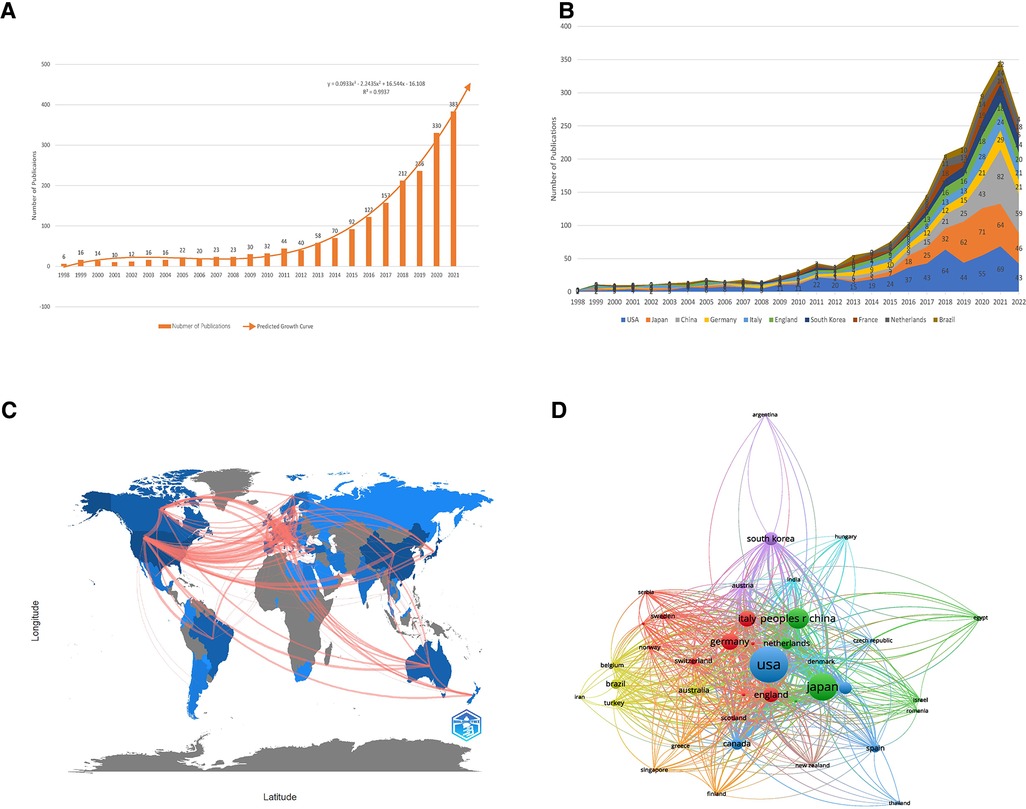
Figure 1. Analysis of general information and countries of publications. (A) The number of publications about the relationship between sarcopenia and surgery from 2000 to 2021; (B) The number of publications of the top 10 most productive countries from 200 to 2022; (C) Map of collaborative relationships between countries; (D) Map of citation relationships between countries. Different nodes present different countries. The size of nodes is proportional to the number of publications in each country, and the color of the lines between two nodes presents the relationship that the countries cited each other. The thicker the lines between two nodes, the higher the frequency with that they are cited to each other.
Analysis of countries or regions
The number of publications of the top ten most productive countries was summarized in Figure 1B according to their publication year. The USA dominate this field before 2015, and the publication number of Japan and China increased rapidly since 2016. In the 3 years from 2019 to 2021, the USA was no longer the most productive country in this field. The researchers in East Asia, especially in Japan and China, published a large number of publications on the relationship between sarcopenia and surgery, and it might be due to East Asia's severely aging societies (20, 21). The detailed information of the most productive 10 countries was summarized in Table 1. Undoubtedly, the USA was the most influential country in the field of the relationship between sarcopenia and surgery, due to its highest H-index and its most publications and cited times (Table 1).
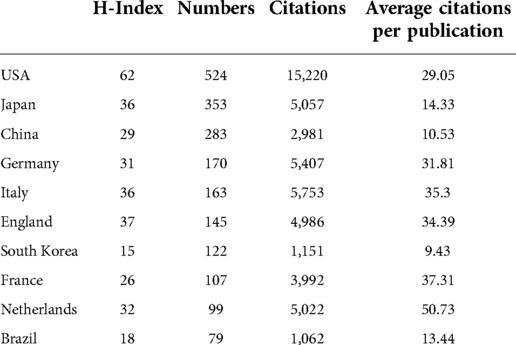
Table 1. The top 10 countries with the largest number of publications on the relationship between sarcopenia and surgery.
Collaboration relationships between countries were visualized in Figure 1C. In this map, the color shape represents the number of publications in each country, and the line represents the collaboration between countries. The USA, Canada, and European countries collaborated most frequently in the past 20 years. The citation relationship between countries were shown in Figure 1D. The size of nodes is proportional to the number of publications in each country, and the color of the lines between two nodes presents the relationship that the countries cited each other. The thicker the lines between two nodes, the higher the frequency that they are cited to each other. The USA, Germany, China, and Japan had the most frequent citation relation (Figure 1D).
Analysis of institutions
A total of 2,703 institutions conducted studies on the relationship between sarcopenia and surgery. The top 10 institutions with the largest number of publications were summarized in Table 2. The Udice French Research Universities was the most productive institution in this field (number of publications = 57), and Harvard University had the highest H-index (H-index = 23). The collaborative relationships between institutions were visualized in Figure 2A. Harvard University, the University of Alberta, and the University Of Milano-Bicocca had the highest TLS, and they were at the center of the collaboration map. Figure 2B showed the citation relationships between institutions. The size of nodes represents the number of citations and the line means their citation relationship. The University of Alberta received the most citations (cited times = 3,277).
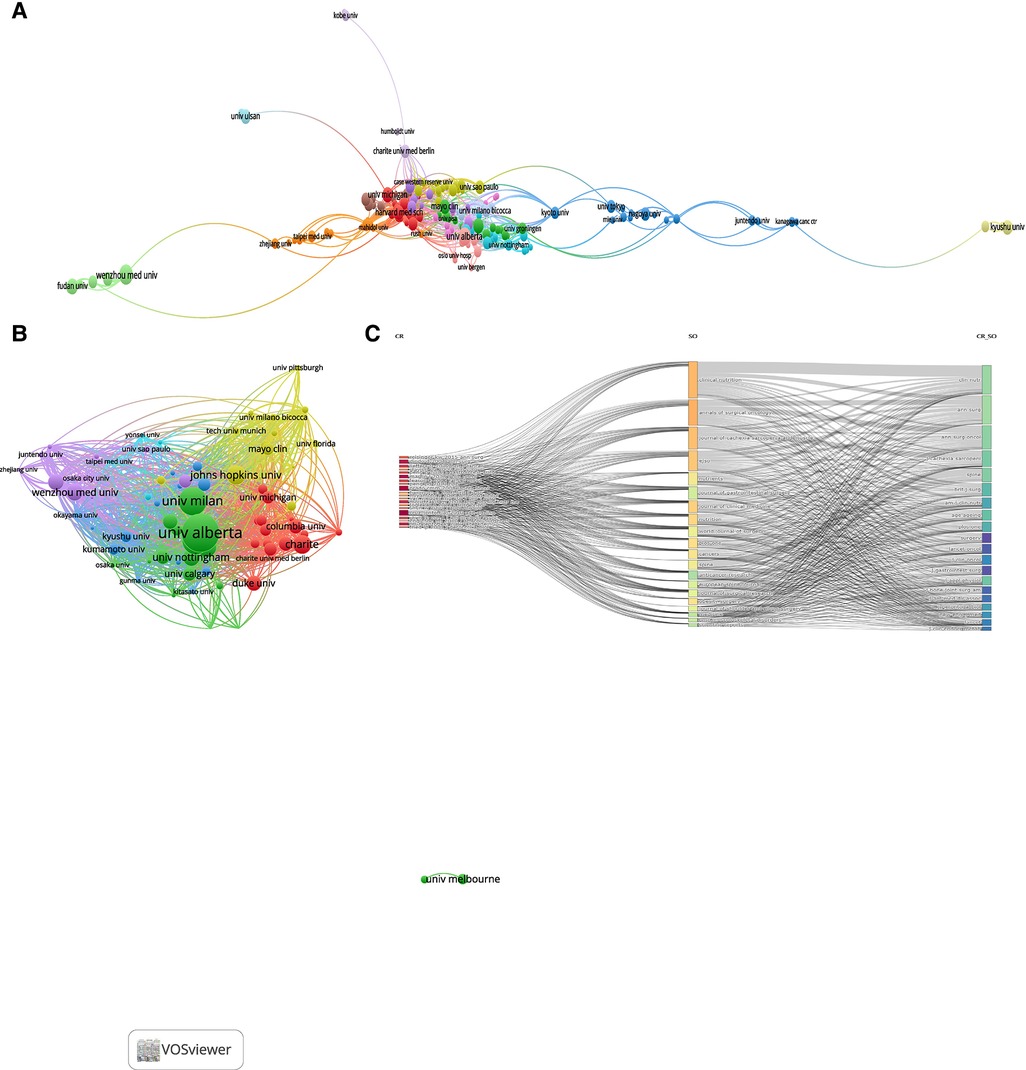
Figure 2. Analysis of relationships between institutions and the cited relationship between journals. (A) Map of collaborative relationships between institutions: different nodes present different institutions. The size of nodes is proportional to the number of publications in each institution, and the color of the lines between two nodes presents the collaborative relationship between institutions; (B) Map of citation relationships between institutions: the size of nodes represents the number of citations and the line means their citation relationship; (C) Map of cited relationships between journals: the left column means the publications with the most co-cited times, the middle column means the journals with the most co-cited times, and the right column means the journals with the most citations.
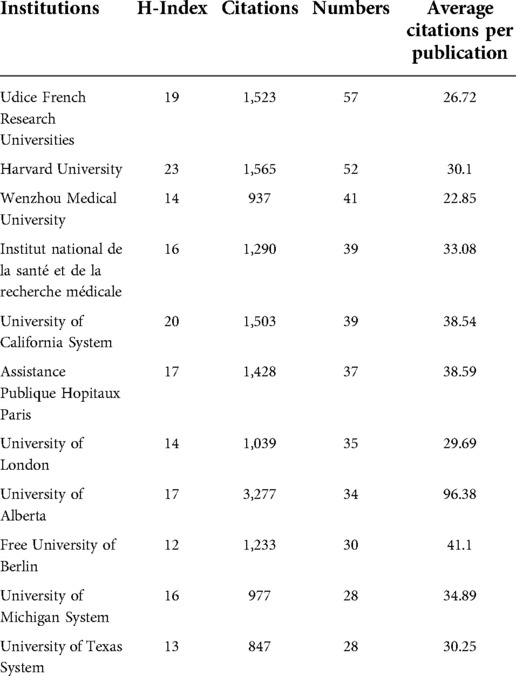
Table 2. The top 10 institutions with the largest number of publications on the relationship between sarcopenia and surgery.
Analysis of journals
A total of 722 journals published studies on the relationship between sarcopenia and surgery. The top 10 journals that published the largest number of studies in this field were summarized and ranked in Table 3. Three journals published more than 40 studies: Annuals of Surgical Oncology (number of publications = 46), Clinical Nutrition (number of publications = 45), and Journal of Cachexia Sarcopenia and Muscle (number of publications = 41). Clinical Nutrition had been cited the most times (3,774 cited times), and the Journal of Cachexia Sarcopenia and Muscle had the highest impact factors (IF = 12.063). The cited relationships in journals could be found in Figure 2C. Clinical Nutrition, Annals of Surgery, and Annuals of Surgical Oncology were the most cited journals in this field.
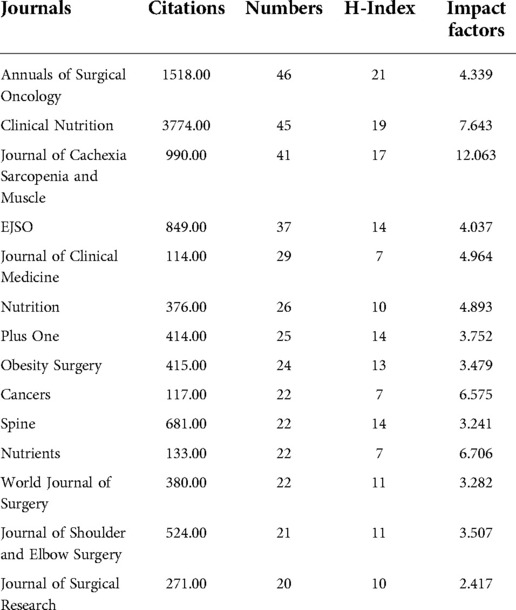
Table 3. The journals with more than 20 publications on the relationship between sarcopenia and surgery.
Analysis of authors
The detailed information including citation times, number of publications, and H-index of the most productive and influential authors in the field of the relationship between sarcopenia and surgery were shown in Tables 4, 5 respectively. Shen Xian was the most productive author in this field (number of publications = 19), and Baracos Vickie was the most influential author, whose studies in this field had been cited 2,209 times. The collaboration relationships of authors were visualized in Figure 3A. The map of author relationships was divided into 8 clusters and the relationships were few and far between clusters. Figure 3B showed the citation relationships between authors, and the cited relationships were wide (Figure 3B).
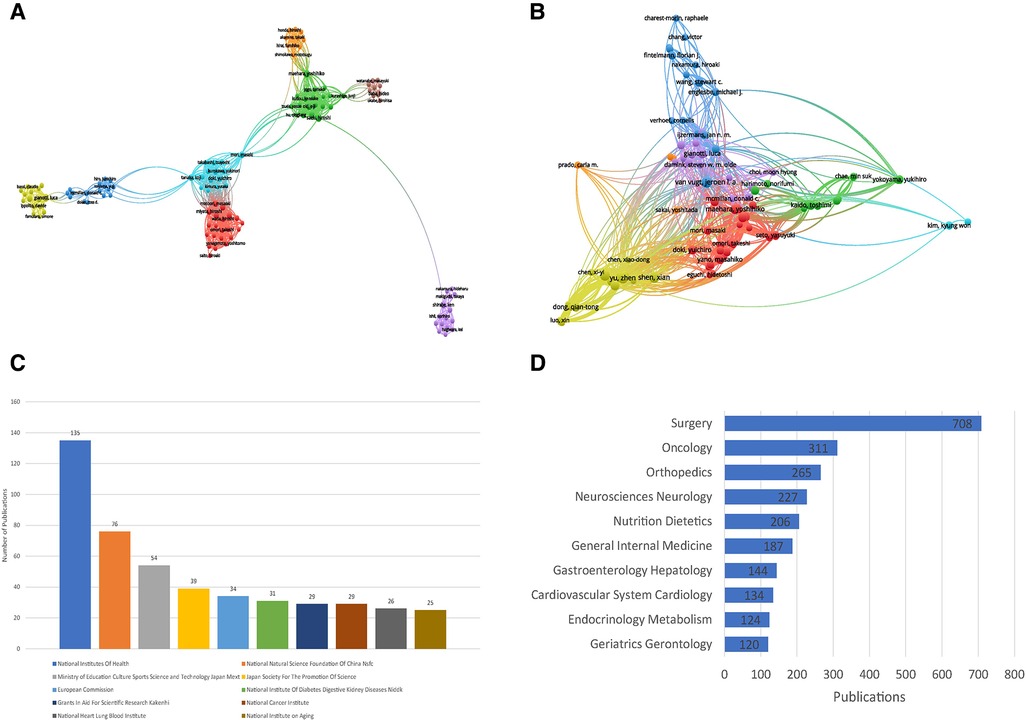
Figure 3. Information of authors, funding agencies, and research directions: (A) Map of collaborative relationships between authors: the size of nodes represents the number of publications and the line means their collaborative relationship; (B) Map of cited relationships between authors: the size of nodes represents the number of citations and the line means their citation relationship; (C) Distribution of the top 10 funding agencies; (D) The information of top 10 research directions.
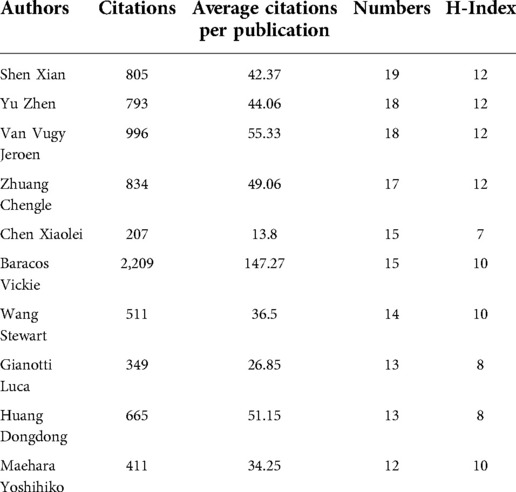
Table 4. The top 10 most productive authors focusing on the relationship between sarcopenia and surgery.
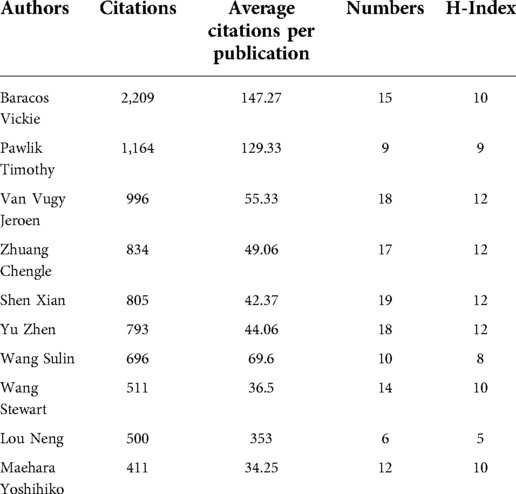
Table 5. The top 10 most influential authors focusing on the relationship between sarcopenia and surgery.
Analysis of funding agencies and research directions
The top 10 funding agencies were summarized in Figure 3C. The National Institutes of Health was the funding agency that funded the largest number of studies (number of funded studies = 135). The National Natural Science Foundation of China and the Ministry of Education Culture Sports Science and Technology Japan Mext funded 76 and 54 studies respectively. Of the top 10 funding agencies, half of them were from the USA. The research directions were summarized in Figure 3D. Most of the studies in this field were focusing on surgery, oncology, and orthopedics.
Analysis of influential studies
The top 10 papers with the largest cited times were shown in Table 6. All of them were published between 2000 and 2017 and were cited more than 300 times. An article entitled “ESPEN guidelines on nutrition in cancer patients” published in Clinical Nutrition has been cited 1,248 times, and was the publication with the most cited times. Figure 4A showed the co-cited relationships in this field. Co-cited publications could reflect the research foundation in this field. A guideline entitled “Sarcopenia: European consensus on definition and diagnosis: Report of the European Working Group on Sarcopenia in Older People” had received the most co-cited times (TLS = 4,444).
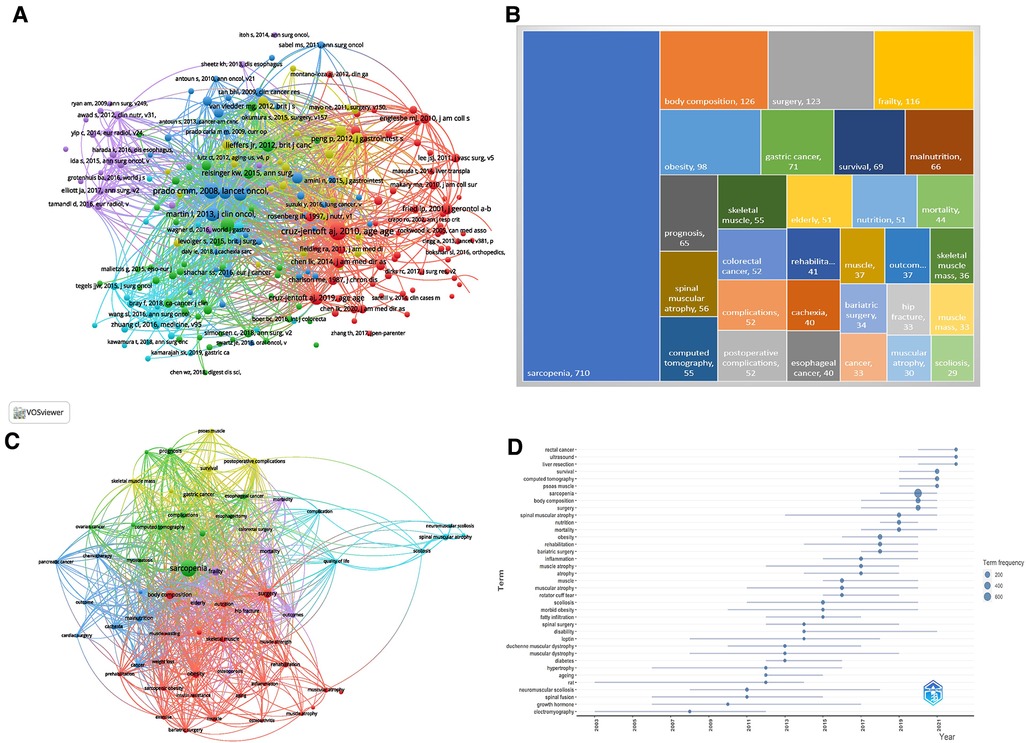
Figure 4. Information of the co-cited publications and keywords: (A) Map of the co-cited relationships of publications: the size of nodes represents the number of co-cited times and the line means their co-cited relationship; (B) Distribution of the top 30 keywords; (C) The map of clusters of keywords: the size of nodes represents the number of co-occurrence times and the line means their co-occurrence relationship. Different color means different clusters; (D) The map of keywords and their occurrence year.
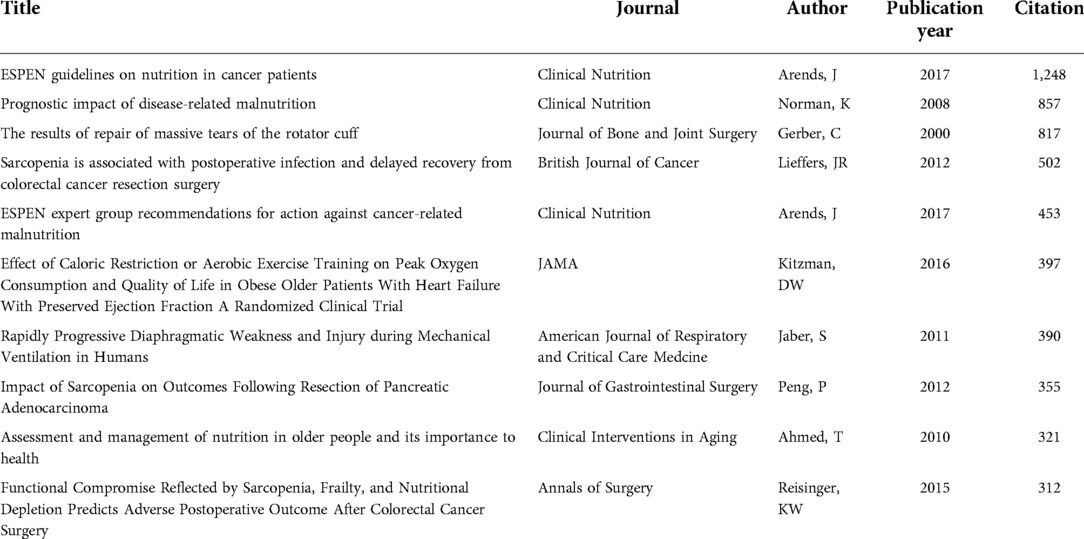
Table 6. The top 10 studies with the most citations on the relationship between sarcopenia and surgery.
Analysis of keywords
Author keywords were extracted from all the papers included in our study. The top 30 most frequent keywords were summarized in Figure 4B. “Sarcopenia”, “body composition”, and “surgery” were the top three keywords with the most occurrences. The cluster analysis was performed and shown in Figure 4C. Keywords were classified into 6 clusters: Cluster 1 (body composition and nutrition), Cluster 2 (sarcopenia), Cluster 3 (malnutrition and cachexia), Cluster 4 (cancer surgery), Cluster 5 (elderly and frailty), Cluster 6 (neuromuscular scoliosis). Figure 4D showed the development of keywords over the past 20 years. At the beginning of this century, researchers in this field paid more attention to neuromuscular scoliosis, and gradually, the emphasis was changed to muscle atrophy. After 2016, sarcopenia had become the most significant research point in this field.
Discussion
In our study, the SCI-E database was used to obtain information on publications on the relationship between sarcopenia and surgery due to its authoritative and comprehensive academic collection (22). The search results of publications on the relationship between sarcopenia and surgery in the SCI-E database may represent the research status in this field comprehensively. Moreover, our study followed the procedures of bibliometric studies suggested previously: (a) identification of search strategies; (b) identification of period and database; (c) identification of inclusion and exclusion criteria; (d) data transformation; (e) data analysis (23).
The relationship between sarcopenia and surgery was still a concern and discussed topic in recent years due to the significant roles played by sarcopenia in surgical procedures, as well as the prognosis after surgeries (24, 25). A study that enrolled 480 older patients with gastrointestinal and hepatobiliary pancreatic tumors showed that patients with poor muscle strength may have poor outcomes after their first resection surgeries (26). Similarly, a study conducted in South Korea showed a similar conclusion: among the patients with resectable pancreatic ductal adenocarcinoma, those with sarcopenia may have lower overall survival and recurrence-free survival after surgery than the patients without sarcopenia (27). Despite the surgeries mentioned above, many studies also suggested the prognosis value of sarcopenia in minimally invasive distal gastrectomy (28), cardiovascular surgery (29), pheochromocytoma and paraganglioma surgery (30), percutaneous kyphoplasty (31), and so on. Otherwise, many studies suggested that the surgery may cause the occurrence and aggravation of sarcopenia (32). A multi-center study conducted in the USA showed that sarcopenia is more prevalent in patients with inflammatory bowel disease undergoing surgery, while the clinical nutrition markers including the body mass index and albumin were similar in the population (33). It is also reported that patients who underwent different methods of pancreatoduodenectomy may also have different changes in skeletal muscle cross-sectional area and visceral fat area, and the incidence of sarcopenia in both surgical procedures continued to increase (34).
Many studies paid more attention to the role of nutrition in sarcopenia and surgery (35–37). A prospective study from China showed that the combined systemic inflammatory immunity index and prognostic nutritional index scores as an indicator of nutrition status may predict the incidence of sarcopenia for patients with advanced gastric cancer who underwent radical surgical resection (38). Moreover, a cohort study conducted in Japan reported that the protein intake may affect the skeletal muscle mass of patients who underwent kidney transplantation, and suggested that a protein intake of more than 0.72 g/kg IBW/day may provide the patients with improved skeletal muscle mass (37). A study based on the data from National Health and Nutrition Examination Survey also suggested the inverse relationship between serum iron and muscle mass (39).
For the analysis of journals, in the top 10 journals with the most publications in this field, 3 journals focused on the field of cancer, and the same number of journals majored in nutrition, which suggested that the relationship between sarcopenia and oncological surgery and the role of nutrition in this field were attracted the most attention. The results of the journal analysis were consistent with the research trend in this field. In the overall bibliometric results, our study had shown that the USA played the most influential role in this field. The USA has published the largest number of publications on the relationship between sarcopenia and surgery and has the highest H-index and the most citations. Similarly, in the analysis of institutions, four of the most productive institutions were from the USA.
Co-cited studies may show the fundamental studies in this field. As shown in Figure 4A, a practice guideline based on The European Working Group on Sarcopenia in Older People (EWGSOP) was the publication with the most co-cited times. This paper was the first consensus on sarcopenia and stated the definition and diagnosis of sarcopenia for the first time (40). However, this consensus was revised in 2019 (13), and the updated guideline reported new insights into sarcopenia: more attention to muscle strength, a more precise clinical algorithm, and more clear cut-off points. The second fundamental study in this field was a population study focusing on the prevalence and clinical implications of sarcopenic obesity in patients with solid tumors of the respiratory and gastrointestinal tracts (41). Similarly, the co-cited study with the third largest number of citations reported that skeletal muscle depletion may predict poor outcomes for patients with cancer cachexia (42). Consistent with the result we mentioned above, more research topics on the relation between sarcopenia and surgery focused on cancer.
Six clusters were generated from the co-occurrence analysis of keywords, and these clusters may indicate the research topics on the relationship between sarcopenia and surgical procedures. Just as we mentioned above, body composition and nutrition are one of the most attractive topics in this field. Body composition is not only the indicator of sarcopenia but is also identified as one of the most significant measurements for the diagnosis of sarcopenia (43). Cluster 3 focused on malnutrition and cachexia. Malnutrition, cachexia, and sarcopenia were similar body statuses with metabolism disorders and were always discussed together (44). Elderly and frailty as the main topic of cluster 4 were also hot research points in recent years due to the understanding of sarcopenia in orthopedics, especially the frailty fractures in older adults (45). Older individuals with poor muscle status may not only face a high incidence of fractures and falls but also poor survival and walking ability after surgeries due to fractures (46, 47). Cluster 6 was the neuromuscular scoliosis. Neuromuscular scoliosis is an abnormal curvature of the spine due to neuromuscular disease (48), and this topic was studied more in the early time in this field.
There were some limitations in our study. First, sarcopenia as a new concept may have rapid development in recent years, while some articles without a clear conception of sarcopenia may fail to be searched. Next, all the publications in our study were attained from SCI-E, one of the most comprehensive and well-known databases. Therefore, many valuable studies indexed in other databases but not in SCI-E may be ignored in our study. Thirdly, some studies published in the recent year may receive fewer citations than those published earlier. Lastly, all the articles included in this study were published in the English language and may contribute to the loss of publications in other languages.
Conclusion
This study revealed the research trend and status of the relationship between sarcopenia and surgery in the recent 20 years. The USA is the most productive and influential country in this field (524 publications and 15,220 citations). The Udice French Research Universities was the most productive institution in this field (57 publications), and the University of Alberta had the largest number of citations. Annuals of Surgical Oncology published the most studies in this field. Shen Xian was the most productive author in this field (number of publications = 19), and Baracos Vickie was the most influential author, whose studies in this field had been cited 2,209 times. The cluster analysis was performed and shown in Figure 4C. Keywords were classified into 6 clusters: Cluster 1 (body composition and nutrition), Cluster 2 (sarcopenia), Cluster 3 (malnutrition and cachexia), Cluster 4 (cancer surgery), Cluster 5 (elderly and frailty), Cluster 6 (neuromuscular scoliosis).
Data availability statement
The original contributions presented in the study are included in the article/Supplementary Material, further inquiries can be directed to the corresponding author/s.
Author contributions
All authors listed have made a substantial, direct, and intellectual contribution to the work and approved it for publication.
Conflict of interest
The authors declare that the research was conducted in the absence of any commercial or financial relationships that could be construed as a potential conflict of interest.
Publisher's note
All claims expressed in this article are solely those of the authors and do not necessarily represent those of their affiliated organizations, or those of the publisher, the editors and the reviewers. Any product that may be evaluated in this article, or claim that may be made by its manufacturer, is not guaranteed or endorsed by the publisher.
References
1. Rosenberg IH. Sarcopenia: origins and clinical relevance. J Nutr. (1997) 127(5 Suppl):990S–1S. doi: 10.1093/jn/127.5.990S
2. Wallengren O, Bosaeus I, Frandin K, Lissner L, Falk Erhag H, Wetterberg H, et al. Comparison of the 2010 and 2019 diagnostic criteria for sarcopenia by the European working group on sarcopenia in older people (ewgsop) in two cohorts of Swedish older adults. BMC Geriatr. (2021) 21(1):600. doi: 10.1186/s12877-021-02533-y
3. Nagai T, Wakabayashi H, Nishioka S, Momosaki R. Functional prognosis in patients with sarcopenic dysphagia: an observational cohort study from the Japanese sarcopenic dysphagia database. Geriatr Gerontol Int. (2022) 22(10):839–45. doi: 10.1111/ggi.14466
4. Cruz-Jentoft AJ, Landi F, Schneider SM, Zuniga C, Arai H, Boirie Y, et al. Prevalence of and interventions for sarcopenia in ageing adults: a systematic review. Report of the international sarcopenia initiative (ewgsop and iwgs). Age Ageing. (2014) 43(6):748–59. doi: 10.1093/ageing/afu115
5. Park B, Bhat S, Wells CI, Barazanchi AWH, Hill AG, MacCormick AD. Short- and long-term impact of sarcopenia on outcomes after emergency laparotomy: a systematic review and meta-analysis. Surgery. (2022) 172(1):436–45. doi: 10.1016/j.surg.2022.02.014
6. Han P, Kang L, Guo Q, Wang J, Zhang W, Shen S, et al. Prevalence and factors associated with sarcopenia in suburb-dwelling older Chinese using the Asian working group for sarcopenia definition. J Gerontol A Biol Sci Med Sci. (2016) 71(4):529–35. doi: 10.1093/gerona/glv108
7. Gonzalez BD, Jim HSL, Small BJ, Sutton SK, Fishman MN, Zachariah B, et al. Changes in physical functioning and muscle strength in men receiving androgen deprivation therapy for prostate cancer: a controlled comparison. Support Care Cancer. (2016) 24(5):2201–7. doi: 10.1007/s00520-015-3016-y
8. Eggelbusch M, Shi A, Broeksma BC, Vazquez-Cruz M, Soares MN, de Wit GMJ, et al. The Nlrp3 inflammasome contributes to inflammation-induced morphological and metabolic alterations in skeletal muscle. J Cachexia Sarcopenia Muscle. (2022). doi: 10.1002/jcsm.13062. [Epub ahead of print]
9. Huot JR, Pin F, Chatterjee R, Bonetto A. Pgc1alpha overexpression preserves muscle mass and function in cisplatin-induced cachexia. J Cachexia Sarcopenia Muscle. (2022) 13(5):2480–91. doi: 10.1002/jcsm.13035
10. Perra T, Sotgiu G, Porcu A. Sarcopenia and risk of pancreatic Fistula after pancreatic surgery: a systematic review. J Clin Med. (2022) 11(14):4144. doi: 10.3390/jcm11144144
11. Miura Y, Nishio K, Kitamura Y, Goto T, Yano M, Matsui S. Surgical risk assessment for super-elderly patients. Geriatr Gerontol Int. (2022) 22(4):271–7. doi: 10.1111/ggi.14340
12. Petermann-Rocha F, Balntzi V, Gray SR, Lara J, Ho FK, Pell JP, et al. Global prevalence of sarcopenia and severe sarcopenia: a systematic review and meta-analysis. J Cachexia Sarcopenia Muscle. (2022) 13(1):86–99. doi: 10.1002/jcsm.12783
13. Cruz-Jentoft AJ, Bahat G, Bauer J, Boirie Y, Bruyere O, Cederholm T, et al. Sarcopenia: revised European consensus on definition and diagnosis. Age Ageing (2019) 48(4):601. doi: 10.1093/ageing/afz046
14. Tsafrir JS, Reis T. Using the citation Index to assess performance. Br Med J. (1990) 301(6764):1333–4. doi: 10.1136/bmj.301.6764.1333-c
15. Ogunsakin RE, Ebenezer O, Ginindza TG. A bibliometric analysis of the literature on norovirus disease from 1991 to 2021. Int J Environ Res Public Health. (2022) 19(5):2508. doi: 10.3390/ijerph19052508
16. Liu T, Mu S, Yang L, Mao H, Ma F, Wang Y, et al. Comprehensive bibliometric analysis of sirtuins: focus on Sirt1 and kidney disease. Front Pharmacol. (2022) 13:966786. doi: 10.3389/fphar.2022.966786
17. Ebenezer O, Shapi M, Tuszynski JA. A review of the recent development in the synthesis and biological evaluations of pyrazole derivatives. Biomedicines. (2022) 10(5):1124. doi: 10.3390/biomedicines10051124
18. van Eck NJ, Waltman L. Software survey: vosviewer, a computer program for bibliometric mapping. Scientometrics. (2010) 84(2):523–38. doi: 10.1007/s11192-009-0146-3
19. Igwaran A, Edoamodu CE. Bibliometric analysis on tuberculosis and tuberculosis-related research trends in Africa: a decade-long study. Antibiotics. (2021) 10(4):423. doi: 10.3390/antibiotics10040423
20. Akiyama H. Aging well: an update. Nutr Rev. (2020) 78(12 Suppl 2):3–9. doi: 10.1093/nutrit/nuaa084
21. Fu L, Fang Y, Yang S, Xu Y. How to make primary healthcare more popular: evidence from the middle-aged and elderly in China. Healthcare. (2022) 10(9):1783. doi: 10.3390/healthcare10091783
22. Dong Q, Zhang J, Han Q, Zhang H, Wang M, Huang Q, et al. Global status and trends in heart failure with preserved ejection fraction over the period 2009-2020: a bibliometric analysis. Medicine. (2022) 101(11):e29106. doi: 10.1097/MD.0000000000029106
23. Ogunsakin RE, Ebenezer O, Jordaan MA, Shapi M, Ginindza TG. Mapping scientific productivity trends and hotspots in remdesivir research publications: a bibliometric study from 2016 to 2021. Int J Environ Res Public Health. (2022) 19(14):8845. doi: 10.3390/ijerph19148845
24. Kim GW, Nam JS, Abidin M, Kim SO, Chin JH, Lee EH, et al. Aso visual abstract: impact of body mass Index and sarcopenia on short- and long-term outcomes after esophageal cancer surgery-an observational study. Ann Surg Oncol. (2022) 29(11):6884–5. doi: 10.1245/s10434-022-12076-0
25. Huang CH, Lue KH, Chen PR, Hsieh TC, Chou YF. Association between sarcopenia and immediate complications and mortality in patients with oral cavity squamous cell carcinoma undergoing surgery. Cancers. (2022) 14(3):785. doi: 10.3390/cancers14030785
26. Nasu N, Yasui-Yamada S, Kagiya N, Takimoto M, Kurokawa Y, Tani-Suzuki Y, et al. Muscle strength is a stronger prognostic factor than muscle mass in patients with gastrointestinal and hepatobiliary pancreatic cancers. Nutrition. (2022) 103-104:111826. doi: 10.1016/j.nut.2022.111826
27. Kim DW, Ahn H, Kim KW, Lee SS, Kim HJ, Ko Y, et al. Prognostic value of sarcopenia and myosteatosis in patients with resectable pancreatic ductal adenocarcinoma. Korean J Radiol. (2022) 23(11):1055–66. doi: 10.3348/kjr.2022.0277
28. Inaguma G, Shibasaki S, Nakauchi M, Serizawa A, Nakamura K, Akimoto S, et al. Muscle mass ratio in male gastric cancer patients as an independent predictor of postoperative complications after minimally invasive distal gastrectomy. Surg Endosc. (2022). doi: 10.1007/s00464-022-09595-y. [Epub ahead of print]36085383
29. Nishikawa R, Fukuda T, Haruyama A, Shibasaki I, Yamaguchi S, Arikawa T, et al. Association between serum gdf-15, myostatin, and sarcopenia in cardiovascular surgery patients. Int J Cardiol Heart Vasc. (2022) 42:101114. doi: 10.1016/j.ijcha.2022.101114
30. Pang Y, Li M, Jiang J, Chen X, Fu Y, Wang C, et al. Impact of body composition and genotype on haemodynamics during surgery for pheochromocytoma and paraganglioma. J Cachexia Sarcopenia Muscle. (2022). doi: 10.1002/jcsm.13071. [Epub ahead of print]
31. Cheng Y, Yang H, Hai Y, Liu Y, Guan L, Pan A, et al. Low paraspinal lean muscle mass is an independent predictor of adjacent vertebral compression fractures after percutaneous kyphoplasty: a propensity score-matched case-control study. Front Surg. (2022) 9:965332. doi: 10.3389/fsurg.2022.965332
32. Lee JK, Park YS, Lee K, Youn SI, Won Y, Min SH, et al. Prognostic significance of surgery-induced sarcopenia in the survival of gastric cancer patients: a sex-specific analysis. J Cachexia Sarcopenia Muscle. (2021) 12(6):1897–907. doi: 10.1002/jcsm.12793
33. Campbell JP, Teigen L, Manski S, Blumhof B, Guglielmo FF, Shivashankar R, et al. Sarcopenia is more prevalent among inflammatory bowel disease patients undergoing surgery and predicts progression to surgery among medically treated patients. Inflamm Bowel Dis. (2022). doi: 10.1093/ibd/izac013. [Epub ahead of print]35166776
34. Jin Q, Ren Q, Chang X, Lu X, Wang G, He N. Pylorus-preserving versus pylorus-resecting: impact on dynamic changes of nutrition and body composition in pancreatic cancer patients before and after pancreatoduodenectomy. Cancer Med. (2022). doi: 10.1002/cam4.5155. [Epub ahead of print]
35. Hayashi H, Shimizu A, Kubota K, Notake T, Masuo H, Yoshizawa T, et al. Combination of sarcopenia and prognostic nutritional index to predict long-term outcomes in patients undergoing initial hepatectomy for hepatocellular carcinoma. Asian J Surg. (2022). doi: 10.1016/j.asjsur.2022.07.122. [Epub ahead of print]
36. Nogueira PLB, Dock-Nascimento DB, de Aguilar-Nascimento JE. Extending the benefit of nutrition intervention beyond the operative setting. Curr Opin Clin Nutr Metab Care. (2022) 25(6):388–92. doi: 10.1097/MCO.0000000000000868
37. Kosoku A, Iwai T, Ishihara T, Kabei K, Nishide S, Maeda K, et al. Influence of protein intake on the changes in skeletal muscle mass after kidney transplantation. Clin Nutr. (2022) 41(9):1881–8. doi: 10.1016/j.clnu.2022.07.028
38. Ding P, Lv J, Sun C, Chen S, Yang P, Tian Y, et al. Combined systemic inflammatory immunity index and prognostic nutritional index scores as a screening marker for sarcopenia in patients with locally advanced gastric cancer. Front Nutr. (2022) 9:981533. doi: 10.3389/fnut.2022.981533
39. Chen Z, Chen J, Song C, Sun J, Liu W. Association between serum iron status and muscle mass in adults: results from nhanes 2015-2018. Front Nutr. (2022) 9:941093. doi: 10.3389/fnut.2022.941093
40. Cruz-Jentoft AJ, Baeyens JP, Bauer JM, Boirie Y, Cederholm T, Landi F, et al. Sarcopenia: European consensus on definition and diagnosis: report of the European working group on sarcopenia in older people. Age Ageing. (2010) 39(4):412–23. doi: 10.1093/ageing/afq034
41. Prado CM, Lieffers JR, McCargar LJ, Reiman T, Sawyer MB, Martin L, et al. Prevalence and clinical implications of sarcopenic obesity in patients with solid tumours of the respiratory and gastrointestinal tracts: a population-based study. Lancet Oncol. (2008) 9(7):629–35. doi: 10.1016/S1470-2045(08)70153-0
42. Martin L, Birdsell L, Macdonald N, Reiman T, Clandinin MT, McCargar LJ, et al. Cancer cachexia in the age of obesity: skeletal muscle depletion is a powerful prognostic factor, independent of body mass index. J Clin Oncol. (2013) 31(12):1539–47. doi: 10.1200/JCO.2012.45.2722
43. Barbosa FA, Nardelli MJ, Cancado GGL, Silva CF, Osorio FMF, Melo RFQ, et al. Sarcopenia, body composition and factors associated with variceal gastrointestinal bleeding and splenectomy in hepatosplenic schistosomiasis mansoni. Trans R Soc Trop Med Hyg. (2022). doi: 10.1093/trstmh/trac052. [Epub ahead of print]
44. Ozola Zalite I, Zykus R, Francisco Gonzalez M, Saygili F, Pukitis A, Gaujoux S, et al. Influence of cachexia and sarcopenia on survival in pancreatic ductal adenocarcinoma: a systematic review. Pancreatology. (2015) 15(1):19–24. doi: 10.1016/j.pan.2014.11.006
45. Shirai N, Inoue T, Ogawa M, Okamura M, Morishita S, Suguru Y, et al. Relationship between nutrition-related problems and falls in hemodialysis patients: a narrative review. Nutrients. (2022) 14(15):3225. doi: 10.3390/nu14153225
46. Han S, Park J, Jang HD, Nah S, Boo J, Han K, et al. Incidence of hip fracture in underweight individuals: a nationwide population-based cohort study in Korea. J Cachexia Sarcopenia Muscle. (2022) 13(5):2473–9. doi: 10.1002/jcsm.13046
47. Nishiomasu K, Ogawa T, Sato K. Indicators of improvement in performing activities of daily living among older patients undergoing rehabilitation following hip fractures. J Aging Phys Act. (2022):1–6. doi: 10.1123/japa.2021-0490. [Epub ahead of print]35894998
Keywords: sarcopenia, surgery, orthopedics, oncology, bibliometric analysis, visualized study
Citation: Liu T, Song F, Su D and Tian X (2023) Bibliometric analysis of research trends in relationship between sarcopenia and surgery. Front. Surg. 9:1056732. doi: 10.3389/fsurg.2022.1056732
Received: 29 September 2022; Accepted: 31 October 2022;
Published: 6 January 2023.
Edited by:
Guixin Sun, Tongji University, ChinaReviewed by:
Oluwakemi Ebenezer, Mangosuthu University of Technology, South AfricaQingbo Chu, Nanyang Second General Hospital, China
© 2023 Liu, Song, Su and Tian. This is an open-access article distributed under the terms of the Creative Commons Attribution License (CC BY). The use, distribution or reproduction in other forums is permitted, provided the original author(s) and the copyright owner(s) are credited and that the original publication in this journal is cited, in accordance with accepted academic practice. No use, distribution or reproduction is permitted which does not comply with these terms.
*Correspondence: Xiaofeng Tian txf@jlu.edu.cn
Specialty Section: This article was submitted to Orthopedic Surgery, a section of the journal Frontiers in Surgery
 Tao Liu
Tao Liu  Xiaofeng Tian
Xiaofeng Tian